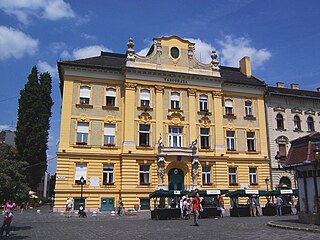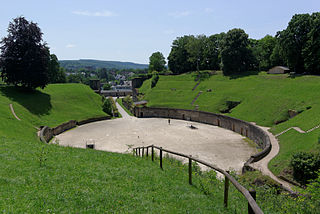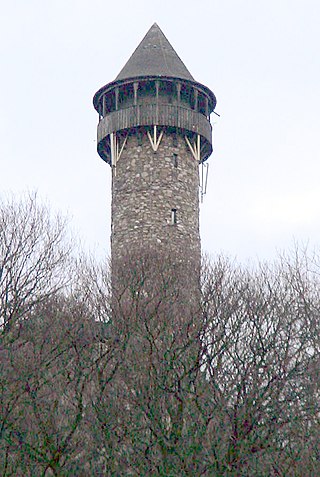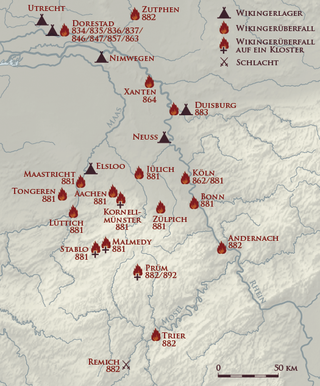
Trier, formerly and traditionally known in English as Trèves and Triers, is a city on the banks of the Moselle in Germany. It lies in a valley between low vine-covered hills of red sandstone in the west of the state of Rhineland-Palatinate, near the border with Luxembourg and within the important Moselle wine region.

An amphitheatre is an open-air venue used for entertainment, performances, and sports. The term derives from the ancient Greek ἀμφιθέατρον, from ἀμφί, meaning "on both sides" or "around" and θέατρον, meaning "place for viewing".

Carnuntum was a Roman legionary fortress and headquarters of the Pannonian fleet from 50 AD. After the 1st century, it was capital of the Pannonia Superior province. It also became a large city of approximately 50,000 inhabitants.

Óbuda is, together with Buda and Pest, one of the three cities that were unified to form the Hungarian capital city of Budapest in 1873. Today, together with Békásmegyer, Óbuda forms a part of the city's third district, although the toponym is also sometimes used for northern Buda as a whole.

Novae was initially one of the few great Roman legionary fortresses along the empire's border, forming part of the defences along the Danube in northern Bulgaria. The settlement later expanded into a town in the Roman province of Moesia Inferior, later Moesia Secunda.

Augusta Treverorum was a Roman city on the Moselle River, from which modern Trier emerged.

The Arena of Nîmes is a Roman amphitheatre in Nîmes, southern France. Built around 100 CE, shortly after the Colosseum of Rome, it is one of the best-preserved Roman amphitheatres in the world. It is 133 metres (436 ft) long and 101 metres (331 ft) wide, with an arena measuring 68 by 38 metres. The outer facade is 21 metres (69 ft) high with two storeys of 60 arcades. It is among the 20 largest Roman amphitheatres of the 400 in existence. In Roman times, the building could hold 24,000 spectators, who were spread over 34 tiers of terraces divided into four self-contained zones or maeniana.

Isca, variously specified as Isca Augusta or Isca Silurum, was the site of a Roman legionary fortress and settlement or vicus, the remains of which lie beneath parts of the present-day suburban town of Caerleon in the north of the city of Newport in South Wales. The site includes Caerleon Amphitheatre and is protected by Cadw.

Trier in Rhineland-Palatinate, whose history dates to the Roman Empire, is the oldest city in Germany. Traditionally it was known in English by its French name of Treves.

The inaugural games were held, on the orders of the Roman Emperor Titus, to celebrate the completion in AD 80 of the Colosseum, then known as the Flavian Amphitheatre.

The Amphitheatre of Pompeii is one of the oldest surviving Roman amphitheatres. It is located in the ancient city of Pompeii, near Naples, and was buried by the eruption of Mount Vesuvius in 79 AD, that also buried the city of Pompeii and the neighbouring town of Herculaneum. Six bodies were found during the excavations.

The Rheinische Landesmuseum Trier is an archaeological museum in Trier, Germany. The collection stretches from prehistory through the Roman period, the Middle Ages to the Baroque era with a strong emphasis on the Roman past of Augusta Treverorum, Germany's oldest city. Its collections of (local) Roman sculptures, Roman mosaics and frescos are among the best in Germany.

The Trier Amphitheater is a Roman amphitheater in Trier, Germany. It is designated as part of the Roman Monuments, Cathedral of St. Peter and Church of Our Lady in Trier UNESCO World Heritage Site as a testimony to the importance of Trier as a major Roman city north of the Alps.

The Barbara Baths are a large Roman bath complex in Augusta Treverorum, modern-day Trier, Germany. Stretching over 42,000 square meters, it is the largest Roman bath north of the Alps. Along with other sites in Trier, the bath complex was designated a UNESCO World Heritage Site in 1986 as part of the Roman Monuments, Cathedral of St. Peter and Church of Our Lady in Trier site, because of its historical importance and sprawling architecture.

The Äskulapstein is a Roman votive stone which was found in the sixteenth century at Godesburg. Today it is kept in the Rheinisches Landesmuseum Bonn.

Wildenburg Castle is a ruined castle near Kempfeld in the county of Birkenfeld in the German state of Rhineland-Palatinate.

The Viking raids in the Rhineland were part of a series of invasions of Francia by the Vikings that took place during the final decades of the 9th century. From the Rhineland, which can be regarded as the nucleus of Frankish culture, the Franks had previously conquered almost the whole of Central Europe and established a great empire.

Cornelia Ewigleben is a German archaeologist and museum director. An alumna of the universities of Trier and Oxford, she has served as the director of two notable German museums: the Historical Museum of the Palatinate from 2000 to 2005, and the Landesmuseum Württemberg from 2005 to 2020. She also edited a book on the politics of the Roman games.

Rainer Vollkommer is a German-Swiss classical archaeologist and art historian.



















